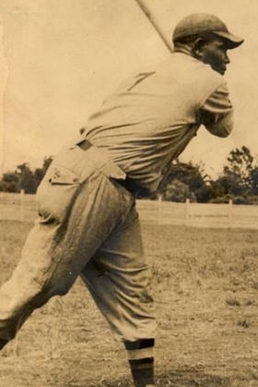Wesley Barrow facts for kids
Quick facts for kids Wesley Barrow |
|
|---|---|
 |
|
| Catcher/Pitcher/Manager | |
| Born: November 13, 1900 West Baton Rouge Parish, Louisiana |
|
| Died: December 24, 1965 (aged 65) Gretna, Louisiana |
|
| debut | |
| 1926, for the Chattanooga Black Lookouts | |
| Career statistics | |
| NNL Managing Record | 31-23-2 |
| Teams | |
As player (incomplete)
As manager
As coach
|
|
Wesley "Big Train" Barrow (born November 13, 1900 – died December 24, 1965) was an American baseball player and manager. He was famous in the Negro Leagues during the 1940s. Many people thought he was one of the best at finding and helping young baseball players in the Southern United States.
Early Life and Baseball Career
Wesley Barrow, Jr. was born on November 13, 1900, in West Baton Rouge Parish, Louisiana. His parents, Wesley Sr. and Nancie, were sharecroppers (farmers who shared their crops with landowners). Wesley finished school after the 6th grade.
As a young man, starting in 1920, he played baseball as a part-time catcher. He played for different semi-pro teams and "barnstorming" teams. Barnstorming teams traveled around, playing exhibition games in different towns. In 1924, he married his wife Mary and they made their home in New Orleans.
Becoming a Professional Player
In 1926, Wesley Barrow started his professional baseball career. He joined the Chattanooga Black Lookouts in the Negro Southern League. A famous pitcher named Satchel Paige was also a rookie on that team.
Barrow and Paige played together again for a short time in 1934. They were part of the legendary Pittsburgh Crawfords team. Barrow even pitched in a game against famous brothers Dizzy and Daffy Dean during a barnstorming tour. He later moved back to New Orleans and joined the New Orleans Black Pelicans in 1939. In 1943, he became a coach and backup catcher for the Cleveland Buckeyes. In 1945, he played for the Harlem Globetrotters, another barnstorming team.
Managing Baseball Teams
Wesley Barrow was also a well-known baseball manager. He led many teams throughout his career.
Managing Independent Teams
From 1940 to 1941, Barrow managed the Algiers Giants. This was an independent team from New Orleans that used to be in the Negro Southern League.
Leading Teams in the Negro Southern League
In 1945, Barrow was chosen to manage the New Orleans Black Pelicans in the Negro Southern League. The next year, 1946, he moved to Tennessee. He managed the Nashville Cubs for the second half of that season. He led them to finish in first place and make it to the playoffs. That same year, he was picked to be a coach for the Eastern team in the Negro Southern League's East-South All-Star Game.
West Coast Baseball
In 1946, a new league called the West Coast Negro Baseball Association started. It had six teams in cities along the Pacific Coast. Wesley Barrow was the manager and starting pitcher for the Portland Rosebuds. This team was owned by the famous track and field athlete, Jesse Owens. However, the league and the Rosebuds team stopped playing after only two months.
Managing in the Negro Major Leagues
After a strong finish in 1946, the Baltimore Elite Giants hired Barrow to be their manager in 1947. They wanted him to help them become a playoff team. The team owner, Tom Wilson, liked Barrow. But Wilson passed away during the season. The new owner, Vernon Greene, did not get along with Barrow.
Some newspapers reported that Barrow made some mistakes. For example, he took a player named Junior Gilliam out of a game after a fielding error. A month later, Greene fined Barrow for not making two players run hard on plays. By the end of July, Greene removed Barrow from his job.
Back to New Orleans
From 1949 to 1950, Barrow played catcher and managed the New Orleans Creoles. This team was part of the Texas Negro League. A female player named Toni Stone also played on this team.
Baseball in Western Canada
After his Creoles team had successful tours in western Canada, Barrow went to Winnipeg, Manitoba. He managed the Elmwood Giants in the Manitoba-Dakota League. This team included both Black and white players. Several Negro League stars joined him on the Giants. However, the team finished in last place. After losing 12 of their first 14 games, Barrow was replaced by Ted Radcliffe.
Later Years in New Orleans
After his time in Canada, Barrow returned to manage the New Orleans Black Pelicans from 1952 to 1953. In 1960, Barrow managed the Detroit-New Orleans Stars in the Negro American League. By this time, the Negro American League was considered a minor league.
Even though the Negro American League stopped in 1961, Barrow kept working in baseball. He managed the Gretna Jax Sports, an independent semi-pro team in Louisiana. He managed this team until May 1965, just a few months before he passed away.
Death and Lasting Impact
Wesley Barrow died from what seemed to be a heart attack on Christmas Eve, 1965. He was visiting friends in Gretna, LA when it happened. He was buried in an unmarked grave at New Hope Baptist Church Cemetery in Gretna.
Years later, a journalist named Ryan Whirty and a former player named Milton Crosby worked together. Because of their efforts, Barrow's grave finally received a headstone in 2015.
In 1968, a park in New Orleans called Pontchartrain Park was renamed after Barrow. The park was damaged by Hurricane Katrina in 2011 and was taken down. A new baseball stadium was built on the same spot. Today, Wesley Barrow Stadium is used for Louisiana high school tournaments, local college teams, and the Major League Baseball Urban Youth Academy.

